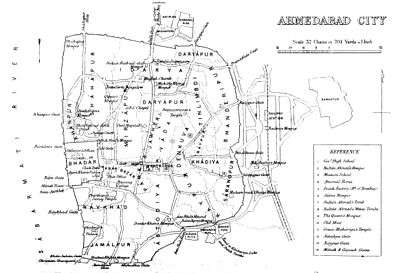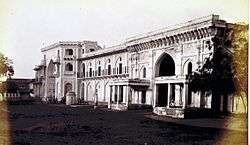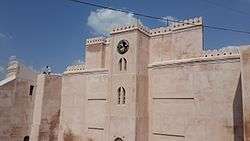Bhadra Fort
| Bhadra Fort | |
|---|---|
| Part of Old Ahmedabad | |
| Ahmedabad, India | |
|
Bhadra Fort from inside and tower clock after renovation | |
| Coordinates | 23°1′25″N 72°34′52″E / 23.02361°N 72.58111°ECoordinates: 23°1′25″N 72°34′52″E / 23.02361°N 72.58111°E |
| Type | Castle and City wall |
| Code | ASI Monument N-GJ-2 |
| Site information | |
| Owner | ASI |
| Controlled by |
Mughal Empire (1573-1744)
Mughal Empire(1744-1758)
|
| Open to the public | Yes |
| Condition | Ruined with survival of western walls and gates |
| Site history | |
| Built | March 4, 1411[2] |
| Built by | Ahmad Shah I of Muzaffarid dynasty |
| Materials | Stone and brick |
| Battles/wars | First Anglo-Maratha War (1779) |
Bhadra Fort is situated in the walled city area of Ahmedabad, India. It was built by Ahmad Shah I in 1411. With its well carved royal palaces, mosques, gates and open spaces, it was renovated in 2014 by Ahmedabad Municipal Corporation (AMC) and Archaeological Survey of India (ASI) as a cultural centre for the city.
Etymology
It is believed the fort adopted the name Bhadra after a temple of Bhadra Kali, a form of Laxmi which was established during Maratha rule[2][3][4] but a plaque near fort tells a different story: The Bhadra Gate - C.A.D. 1411 - The massive fortified gate was built in or about 1411 to serve as the principal eastern entrance of the palace erected here by Sultan Ahmad Shah I (1411-1442), the founder of Ahmedabad. The palace called the Bhadra after the ancient Rajput citadel of that name at Anhilwada-Patan (Baroda State), which the first three kings of the dynasty of Gujarat Sultans had held before Ahmedabad became the capital. Three inscribed slabs on the walls connecting this gateway with two ancillary gates behind are now almost completely defaced. One of these appears to show a date of the time of Jahangir (1605-1627). [5][6]
History
Ahmedabad was named after Ahmad Shah I of the Muzaffarid dynasty who captured Karnavati in 1411. He established Ahmedabad as the new capital of Gujarat Sultanate and built Bhadra Fort on the east bank of the Sabarmati river. It was also known as Arak Fort as described in Mirat-i-Ahmadi. The foundation stone of fort was laid down at Manek Burj in 1411. Square in form, enclosing an area of about forty-three acres, and containing 162 houses, the Bhadra fort had eight gates, three large, two in the east and one in the south-west corner; three middle-sized, two in the north and one in the south; and two small, in the west.[6] The area within the fort had become occupied by urban developments by 1525.[2][3] So a second fortification was built later by Mahmud Begada, the grandson of Ahmed Shah, with an outer wall 10 km (6.2 mi) in circumference and consisting of 12 gates, 189 bastions and over 6,000 battlements as described in Mirat-i-Ahmadi.[7] Almost 60 governors ruled Gujarat during the Mughal period including the future Mughal emperors Jahangir, Shah Jahan and Aurangzeb.[8][9] A seraglio was built later in the 17th century by a Mughal governor, Azam Khan, known as Azam Khan Sarai.[1][3] It was used as a Musafir khana (a resting place for travellers) during Mughal rule.[4][10]
Sarsenapati Umabaisaheb Khanderao Dabhade became the only female Commander-in-Chief in the history of the Marathas in 1732. She commanded the Maratha Army and fought a war near Ahmedabad at Bhadra Fort defeating Mughal Sardar Joravar Khan Babi.
Joint rule by Peshwa and Gaekwad of the Maratha Empire brought an end to the Mughal era in 1583. During the First Anglo–Maratha War (1775–1782), General Thomas Wyndham Goddard with 6,000 troops stormed Bhadra Fort and captured Ahmedabad on February 15, 1779. There was a garrison of 6,000 Arab and Sindhi infantry and 2,000 horses. Losses in the fight totalled 108, including two Britons. After the war, the fort was later handed back to Marathas under the Treaty of Salbai.[10][11][12]
Ahmedabad was conquered by the British in 1817.[3] The fort complex was used as a jail during the British Raj.[4]
Azam Khan sarai currently houses the government offices, an ASI office, a post office and the city's civil courts. It is also used for flag hoisting on Independence Day and Republic Day.[4][10]
Structures

Citadel, royal square and Teen Darwaza

Bhadra Fort housed royal palaces and the beautiful Nagina Baugh and the royal Ahmed Shah's Mosque on the west side and an open area known as Maidan-Shah on the east side. It had a fortified city wall with 14 towers, eight gates and two large openings covering an area of 43 acres. The eastern wall on the river bank can still be seen. The fort complex was used as a royal court during his reign. On the eastern side of a fort, there is a triple gateway known as Teen Darwaza which was formerly an entrance to the royal square, Maidan-Shah. The road beyond Teen Darwaza leads Manek Chowk, a mercantile square. On the south side along the road, there is a congregational mosque known as Jami Masjid.[2][3][4]
The citadel's architecture is Indo-sarcenic with intricately carved arches and balconies. Fine lattice work adorns windows and murals. There are some Islamic inscriptions on the arches of the fort. The palace contains royal suites, the imperial court, halls and a prison.[2][3][4]
The Maidan-Shah, or the kings market, is at least 1600 feet long and half as many broad and beset all about with rows of Palm-trees and Date-trees intermixed with Citron-trees and Orange-trees, whereof there are very many in the several streets: which is not only verry pleasant to the sight, by the delightful prospect it affords, but also makes the walking among them more convenient by reason of the coolness. Besides this Maidan, there are in the city four Bazaars, or public places, where are sold all kind of merchandise.— Johan Albrecht de Mandelslo, German traveller; in October, 1638, Mandelslo's Travels In Western India, Page 22[10][13]
Azam Khan Sarai

Azam Khan, also known as Mir Muhammad Baquir was a Mughal governor. He built a palace known as Azam Khan Sarai in 1637. Its entrance, 5.49 meters high, opens onto an octagonal hall which had a low balcony made up of stone in the upper floor. It was used as a resting place for travellers in the Mughal era and as a hospital and a jail during British rule.[9][14] There was a gibbet on the roof of Azam Khan Sarai used for hanging during the Gujarat sultanate and the British era. According to one story, it was here Ahmed Shah hanged his son-in-law who was convicted of murder.[15]
Bhadra Kali Temple
A room in north wing of Azam Khan Sarai was turned into the temple of Bhadra Kali during Maratha rule.[2][4] It has a black statue of Goddess Bhadra Kali with four hands.
- Legend
Years ago, Laxmi, the Goddess of Wealth, came to the gate of Bhadra Fort to leave the city in the night. Watchman Siddique Kotwal stopped her and identified her. He asked her not to leave fort until he obtained permission from the king. He beheaded himself in order to keep Laxmi in the city. It resulted in the prosperity of the city.[16]
There is a tomb near Bhadra Gate dedicated to Siddique Kotwal and a temple to Bhadra Kali, representing Laxmi.[16] A lamp in one of the hole in Teen Darwaza is lit continuously for more than six hundred years by a Muslim family is dedicated to Laxmi.[17]
Clock tower
The Bhadra Fort tower clock was brought from London in 1849 at cost of Rs. 8000 and installed here at the cost of £243 (Rs. 2430) in 1878 by the British East India Company. At night, it was illuminated from behind by a kerosene lamp which was replaced by an electric light in 1915. Ahmedabad's first electrical connection, it ceased to operate in the 1960s but the AMC and the ASI now plan to repair it.[18][19]
Redevelopment
Under Bhadra Plaza Development Project, an initiative of the AMC and the ASI, Bhadra Fort was renovated and the open space between the fort and Teen Darwaza, earlier known as Maidan-Shah was restored. Landscaping was recreated based on the accounts of historical past travellers. The work started on 26 January 2012 and the renovation of open areas was completed in November 2014.[20] The cost of the project is estimated Rs 115 crore. A stretch between the fort and Teen Darwaza earlier known as Maidan-Shah was declared a pedestrian zone. The new public amenities, marble banches and kiosks for hawkers were constructed.[21] There are also plans for a pedestrian bridge connecting Bhadra plaza with the Sabarmati riverfront and a multilevel car park at Lal Darwaza. The museum and galleries are planned on the first floor of the fort palace while a handicraft outlet will be housed on the ground floor. A traditional restaurant, food and ethnic markets as well as an exhibition centre are also planned.[4][10][22][23][24][25] It is the first heritage and pedestrianization project under JnNURM.[26] Jaishankar Sundari hall, a performing arts venue, was renovated and reopened in 2010.[27]
The city civil court and sessions court were operated in buildings adjacent to Azam Khan Sarai. They were transferred to old high court building on Ashram Road. The new eight floor court building is planned after demolition of old buildings. The plan was challenged in Gujarat High Court citing protected monument laws and regulations but high court permitted the construction after presentation by authorities.[28][29]
Recognition
Gallery
-
Bhadra Fort inscription
-
Bhadra fort gate from inside
-
Statue of Chinubhai Baronet in Royal Square
-
Roadside vendors at Teen Darwaza
See also
References
- 1 2 "History". Official Website. Ahmedabad Municipal Corporation. Archived from the original on February 23, 2016. Retrieved January 16, 2013.
- 1 2 3 4 5 6 "Bhadra Fort". NRI Division. Government of Gujarat. June 25, 2010. Retrieved January 16, 2013.
- 1 2 3 4 5 6 Bloom, Jonathan; Blair, Sheila (2009). Grove Encyclopedia of Islamic Art & Architecture. 2. Oxford University Press. pp. 37–39. ISBN 978-0-19-530991-1.
- 1 2 3 4 5 6 7 8 John, Paul (July 6, 2011). "Strolling atop Bhadra fort". The Times of India. Ahmedabad. TNN. Retrieved January 17, 2013.
- ↑ Dalal, Sonali (July 22, 2010). "Bhadra". Retrieved January 17, 2013.
- 1 2 Gazetteer of the Bombay Presidency: Ahmedabad. Government Central Press. 1879. p. 275.
- ↑ G. Kuppuram (1988). India through the ages: history, art, culture, and religion. 2. Sundeep Prakashan. p. 739.
- ↑ John, Paul (July 29, 2012). "No entry for Shah Jahan". The Times of India. TNN. Retrieved January 17, 2013.
- 1 2 Desai, Hemang (Nov 26, 2010). "The story of how architecture in Gujarat got a Mughal touch…". DNA. Ahmedabad. Retrieved January 17, 2013.
- 1 2 3 4 5 "Bhadra Fort to turn into heritage hangout!". The Times of India. Ahmedabad. TNN. June 12, 2009. Retrieved January 17, 2013.
- ↑ Duff, James Grant (1826) [Oxford University]. A History of the Mahrattas. 2. London: Longman, Rees, Orme, Brown, and Green.
- ↑ Beveridge, Henry (1862) [New York Public Library]. A comprehensive history of India, civil, military and social. Blackie. pp. 456–466.
- ↑ Commissariat, M. S. (1996). Mandelslo's Travels In Western India. Asian Educational Services. pp. 22–23. ISBN 978-81-206-0714-9.
- ↑ John, Paul (July 29, 2012). "Mughal icons decaying in city". The Times of India. Ahmedabad. TNN. Retrieved January 17, 2013.
- ↑ Shah, Charul (March 3, 2011). "Godhra case: How noose tightened over ages in Bhadra". Daily News and Analysis. DNA. Retrieved January 17, 2013.
- 1 2 Jadav, Ruturaj (February 24, 2011). "Kankaria to showcase city". Ahmedabad Mirror. Retrieved February 22, 2013.
- ↑ "Lamp of hope burns bright at historic Teen Darwaza". The Times of India. 3 September 2013. Retrieved 11 January 2015.
- ↑ "Pioneers' paradise". The Times of India. TNN. November 25, 2012. Retrieved January 17, 2013.
- ↑ John, Paul (8 June 2011). "Bhadra fort clock to tick soon". The Times of India. TNN. Retrieved January 17, 2013.
- ↑ Tewari, Ankur (20 November 2014). "On road less travelled by chaos, Bhadra blooms". The Times of India. Retrieved 2 December 2014.
- ↑ "Will Bhadra plaza be picture perfect?". The Times of India. 2 November 2014. Retrieved 2 December 2014.
- ↑ "Bhadra plaza development project from 26 January, watch in images". DeshGujarat.com. January 13, 2012. Retrieved January 16, 2013.
- ↑ "Ahmedabad's Bhadra Fort to remain shut for vehicles from Jan 27". Daily News and Analysis. DNA. January 14, 2012. pp. Ahmedabad. Retrieved January 16, 2013.
- ↑ Devarhubli, Chaitra (July 15, 2012). "Bhadra fort may get date palms to signify history". Daily News and Analysis. Ahmedabad. DNA. Retrieved January 17, 2013.
- ↑ "From Jan 27, Bhadra will be closed to all vehicles". Daily Bhaskar. DNA. January 14, 2012. Retrieved January 17, 2013.
- 1 2 "Bhadra revitalization project wins HUDCO award". The Times of India. TNN. February 21, 2013. Retrieved March 6, 2013.
- ↑ Mistry, Manish (July 10, 2010). "Famed Jaishankar hall will reopen in August". Ahmedabad Mirror.
- ↑ "HC gives nod for demolition of old court building at Bhadra". The Times of India. August 9, 2014.
- ↑ "Gujarat high court stays construction of new Bhadra court building". The Times of India. May 22, 2014.
- This article contains public domain text from Gazetteer of the Bombay Presidency: Ahmedabad. Government Central Press. 1879. p. 275.
External links
| Wikimedia Commons has media related to Bhadra Fort. |
